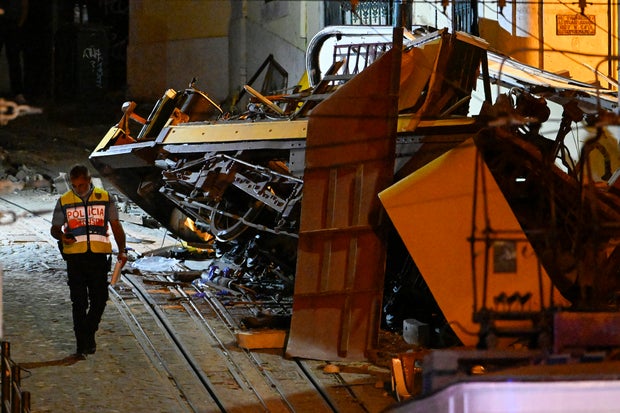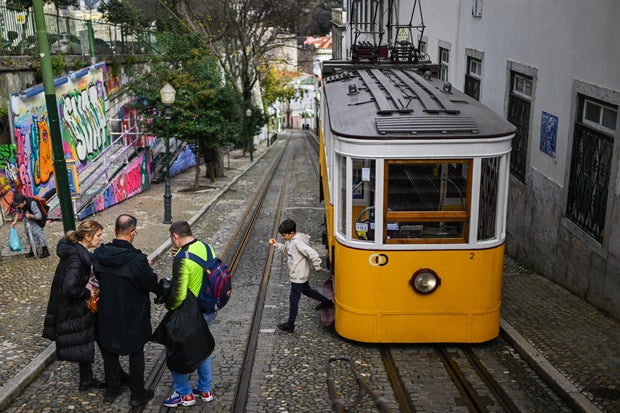Lisbon — Portugal was reeling Thursday morning in the wake of an unprecedented disaster in the heart of its capital city. Sixteen people were killed late Wednesday afternoon when one of Lisbon’s trademark electric streetcars — the Elevador da Gloria funicular — careened off its tracks and slammed into a building.
The funicular, a type of tram usually set on a permanent angle to run up and down a hill or mountain, has carried people about 270 yards up and down a hill in central Lisbon for more than a century. It’s hugely popular with tourists, and The Associated Press said about half of the 21 people injured in the crash were foreign visitors.
The Reuters news agency said emergency services had confirmed three other funiculars in Lisbon were undergoing additional safety checks Thursday following the deadly crash.
Zed Jameson/Anadolu/Getty
Margarida Castro Martins, who heads Lisbon’s Civil Protection Agency, earlier told reporters that two people who were hospitalized after the crash on Wednesday night had died, bringing the death toll to 17, but the agency corrected that figure later Thursday, citing a duplication of information earlier in the day, according to The Associated Press.
Officials haven’t released the names of the victims, but rescuers have said there were foreign nationals among those killed.
Portuguese President Marcelo Rebelo de Sousa offered condolences to the affected families, and Lisbon’s Mayor Carlos Moedas said the city would be in mourning for three days.
“It’s a tragedy of the like we’ve never seen,” Moedas said.
Horacio Villalobos/Getty
“A tragic accident … caused the irreparable loss of human life, which left in mourning their families and dismayed the whole country,” the national government said in a statement, declaring Thursday a national day of mourning.
This streetcar was still a heap of crumpled metal surrounded by police cordons on Thursday. It would typically be packed with visitors at this time of year.
As the smoke cleared over the wreckage on Wednesday, it revealed the scene where the famed Elevador da Gloria had careened about 800 feet down the steep hill it’s traversed for about 140 years before it derailed on a bend and crashed into a building.
Horacio Villalobos/Corbis/via Getty
Some onlookers rushed to help after the crash, but others fled in fear of the noise and chaos.
“The only thing we could do was turn and run,” said one man who saw the accident.
“It’s a tragic situation, truly tragic,” another local resident, Carla Gomes, told the French news agency AFP.
For many tourists visiting Lisbon, a ride on the iconic streetcar is a must-do. Millions of people take the roughly four-minute trip every year.
PATRICIA DE MELO MOREIRA/AFP/Getty
The Elevador da Gloria operates in the same manner as hillside funiculars all over Europe and elsewhere, with two cars attached at opposing ends of a circular cable — as one car goes up, the other goes down. The Lisbon funicular is powered by motors in each car, which run on electricity delivered via separate overhead cables.
Local reports have speculated that the primary cable may have snapped, though officials have not commented on the reports.
Cable and brake failures are two of the most common causes of streetcar accidents.
Speaking to CBS News, the president of the Portuguese Order of the Engineers, Almeis Santos, said the accident appeared to be caused by the rupture of the cable.
“It’s very strange… for this kind of cable. It’s not normal and it’s almost impossible to have [a] sudden rupture,” he said.
Santos went on to suggest that the sudden snapping of the cable would not be enough for either the manual or automatic brakes that were present to hold back the roughly 20 tons of weight of the street car and passengers.
Carris, the company that operates the Elevador da Gloria, has said regular inspections — including daily checks — had been carried out as required.
An investigation is now underway into the disaster, which has shattered the charm of the quiet European capital.



